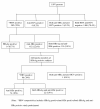Prevalence and risk factors of hepatitis B and C virus infections in an impoverished urban community in Dhaka, Bangladesh
- PMID: 20630111
- PMCID: PMC2918606
- DOI: 10.1186/1471-2334-10-208
Prevalence and risk factors of hepatitis B and C virus infections in an impoverished urban community in Dhaka, Bangladesh
Abstract
Background: Viral hepatitis is a serious global public health problem affecting billions of people globally, and both hepatitis B virus (HBV) and hepatitis C virus (HCV) infections are rapidly spreading in the developing countries including Bangladesh due to the lack of health education, poverty, illiteracy and lack of hepatitis B vaccination. Also there is lack of information on their prevalence among the general population. So, a population-based serological survey was conducted in Dhaka to determine the prevalence and risk factors of HBV and HCV infections.
Methods: Healthy individuals were selected for demographic and behavioural characteristics by stratified cluster sampling and blood tested for hepatitis B surface antigen (HBsAg), antibody to HBV core antigen (anti-HBc), and anti-HCV antibodies (anti-HCV).
Results: From June 2005-November 2006, 1997 participants were screened for HBsAg, anti-HBc and anti-HCV, 738 (37%) were males with mean (SD) age of 24 (14) years. HBV-seropositivity was documented in 582 (29%) participants: 14 (0.7%) were positive for HBsAg, 452 (22.6%) for anti-HBc and 116 (5.8%) for both HBsAg and anti-HBc. Four (0.2%) participants were positive for anti-HCV, and another five (0.3%) for both anti-HBc and anti-HCV. Ninety-six/246 (39%) family members residing at same households with HBsAg positive participants were also HBV-seropositive [74 (30.1%) for anti-HBc and 22 (8.9%) for both HBsAg and anti-HBc], which was significantly higher among family members (39%) than that of study participants (29%) (OR 1.56; p < 0.001). In bivariate analysis, HBV-seropositivity was significantly associated with married status (OR 2.27; p < 0.001), history of jaundice (OR 1.35; p = 0.009), surgical operations (OR 1.26; p = 0.04), needle-stick injuries (OR 2.09; p = 0.002), visiting unregistered health-care providers (OR 1.40; p = 0.008), receiving treatment for sexually transmitted diseases (STD) (OR 1.79; p = 0.001), animal bites (OR 1.73; p < 0.001); ear-nose-body piercing in females (OR 4.97; p < 0.001); circumcision (OR 3.21; p < 0.001), and visiting community barber for shaving in males (OR 3.77; p < 0.001). In logistic regression analysis, married status (OR 1.32; p = 0.04), surgical operations (OR 1.39; p = 0.02), animal bites (OR 1.43; p = 0.02), visiting unregistered health-care providers (OR 1.40; p = 0.01); and ear-nose-body piercing in females (OR 4.97; p < 0.001) were significantly associated with HBV-seropositivity.
Conclusions: The results indicate intermediate level of endemicity of HBV infection in Dhaka community, with much higher prevalence among family members of HBsAg positive individuals but low prevalence of HCV infections, clearly indicating need for universal hepatitis B vaccination. The use of disposable needles for ear-nose-body piercing need to be promoted through public awareness programmes as a preventive strategy.
Similar articles
-
Prevalence and risk factors of hepatitis B and C virus infections among the general population and blood donors in Morocco.BMC Public Health. 2013 Jan 18;13:50. doi: 10.1186/1471-2458-13-50. BMC Public Health. 2013. PMID: 23331910 Free PMC article.
-
[Seroprevalence and Risk Factors of Hepatitis B, C and D in Adults in Trabzon, Türkiye].Mikrobiyol Bul. 2024 Jul;58(3):293-308. doi: 10.5578/mb.20249762. Mikrobiyol Bul. 2024. PMID: 39046211 Turkish.
-
Prevalence of hepatitis B virus infection among health care workers in a tertiary hospital in Tanzania.BMC Infect Dis. 2015 Sep 23;15:386. doi: 10.1186/s12879-015-1129-z. BMC Infect Dis. 2015. PMID: 26399765 Free PMC article.
-
Global epidemiology of hepatitis B and hepatitis C in people who inject drugs: results of systematic reviews.Lancet. 2011 Aug 13;378(9791):571-83. doi: 10.1016/S0140-6736(11)61097-0. Epub 2011 Jul 27. Lancet. 2011. PMID: 21802134 Free PMC article. Review.
-
Hepatitis B virus seroepidemiology data for Africa: Modelling intervention strategies based on a systematic review and meta-analysis.PLoS Med. 2020 Apr 21;17(4):e1003068. doi: 10.1371/journal.pmed.1003068. eCollection 2020 Apr. PLoS Med. 2020. PMID: 32315297 Free PMC article.
Cited by
-
Population-attributable estimates for risk factors associated with hepatitis B and C: policy implications for Pakistan and other South Asian countries.Hepatol Int. 2013 Jun;7(2):500-7. doi: 10.1007/s12072-012-9417-9. Epub 2013 Jan 10. Hepatol Int. 2013. PMID: 26201782
-
The prevalence of hepatitis B virus infection in Bangladesh: a systematic review and meta-analysis.Epidemiol Infect. 2022 Feb 14;150:e47. doi: 10.1017/S0950268822000061. Epidemiol Infect. 2022. PMID: 35156592 Free PMC article.
-
Hepatitis B seroprevalence and risk factors in adult population of chaharmahal and bakhtiari province in 2013.Hepat Mon. 2014 May 3;14(5):e17398. doi: 10.5812/hepatmon.17389. eCollection 2014 May. Hepat Mon. 2014. PMID: 24910705 Free PMC article.
-
Low frequency of male circumcision and unwillingness to be circumcised among MSM in Buenos Aires, Argentina: association with sexually transmitted infections.J Int AIDS Soc. 2013 Jun 6;16(1):18500. doi: 10.7448/IAS.16.1.18500. J Int AIDS Soc. 2013. PMID: 23746302 Free PMC article.
-
Hepatitis B: Epidemiology and prevention in developing countries.World J Hepatol. 2012 Mar 27;4(3):74-80. doi: 10.4254/wjh.v4.i3.74. World J Hepatol. 2012. PMID: 22489259 Free PMC article.
References
-
- Khan WI, Sultana R, Rahman M, Akhter H, Haq JA, Ali L, Mohsin MA, Khan AK. Viral hepatitis: recent experiences from serological studies in Bangladesh. Asian Pac J Allergy Immunol. 2000;18:99–103. - PubMed
-
- Hepatitis B. 2008. http://www.who.int/mediacentre/factsheets/fs204/en
-
- Islam MN, Islam KM, Islam N. Hepatitis-B virus infection in Dhaka, Bangladesh. Bangladesh Med Res Counc Bull. 1984;10:1–6. - PubMed
-
- Rumi MA, Begum K, Hassan MS, Hasan SM, Azam MG, Hasan KN, Shirin M, Khan AK. Detection of hepatitis B surface antigen in pregnant women attending a public hospital for delivery: implication for vaccination strategy in Bangladesh. Am J Trop Med Hyg. 1998;59:318–22. - PubMed
Publication types
MeSH terms
Substances
LinkOut - more resources
Full Text Sources
Medical
Research Materials


